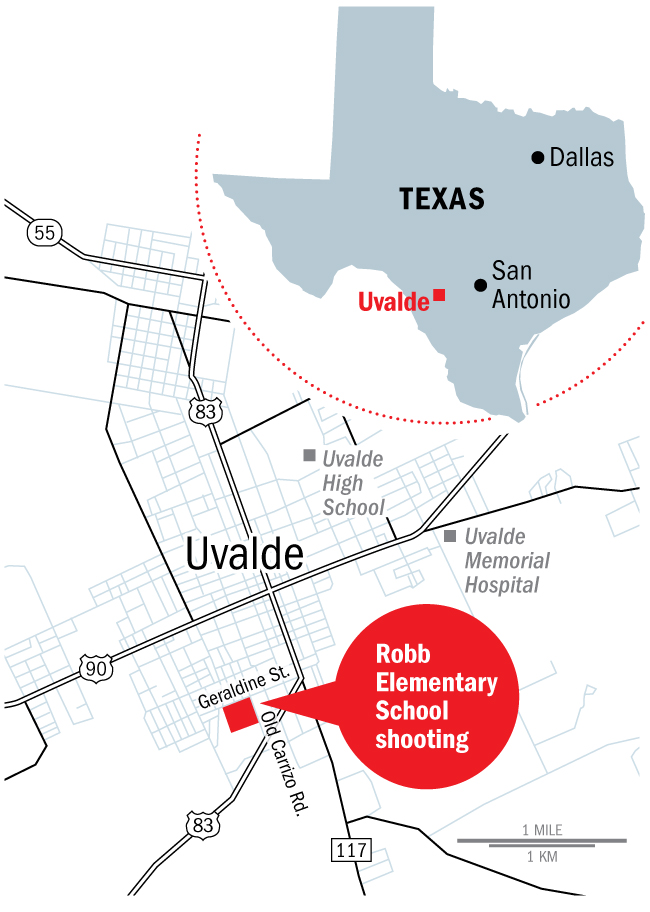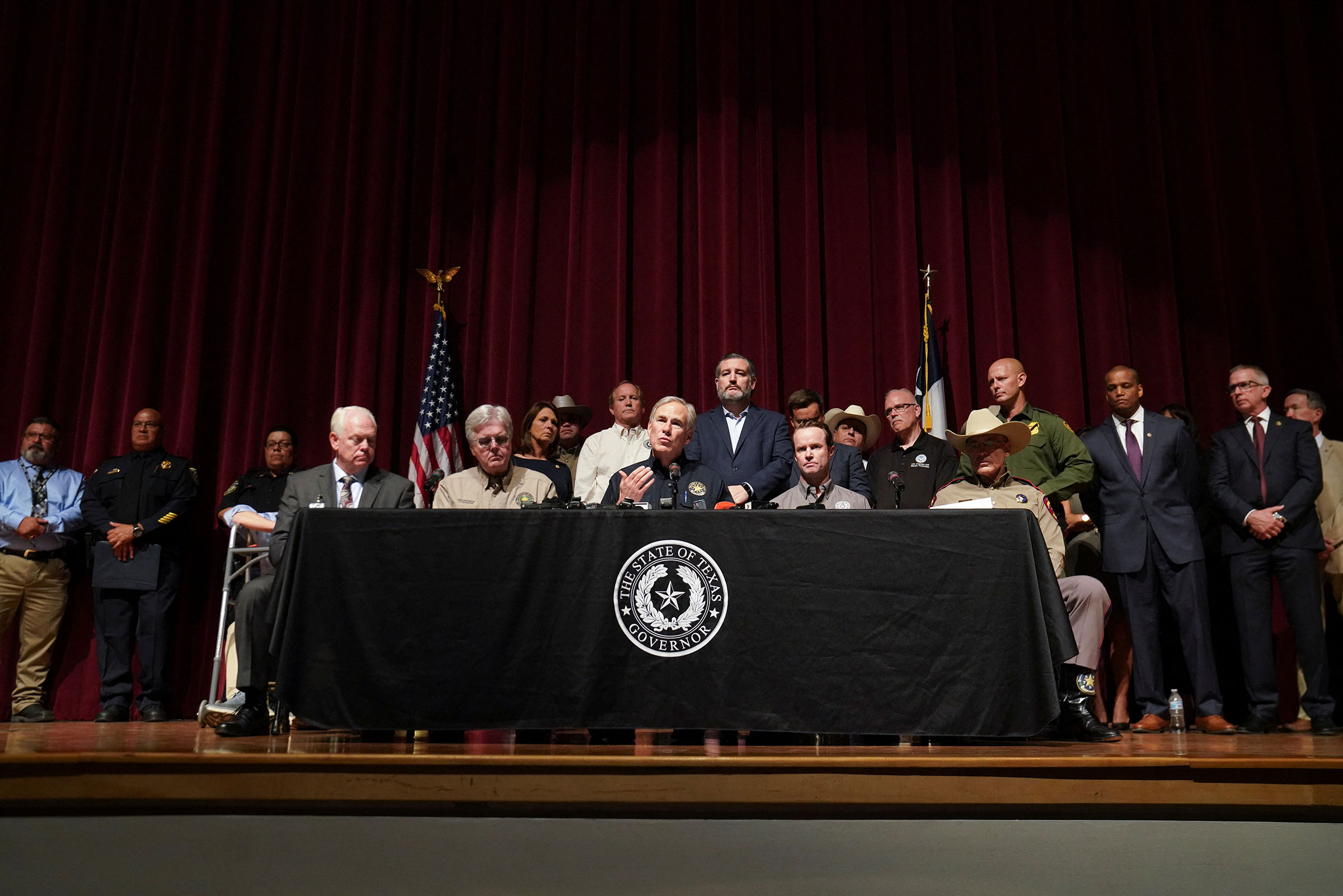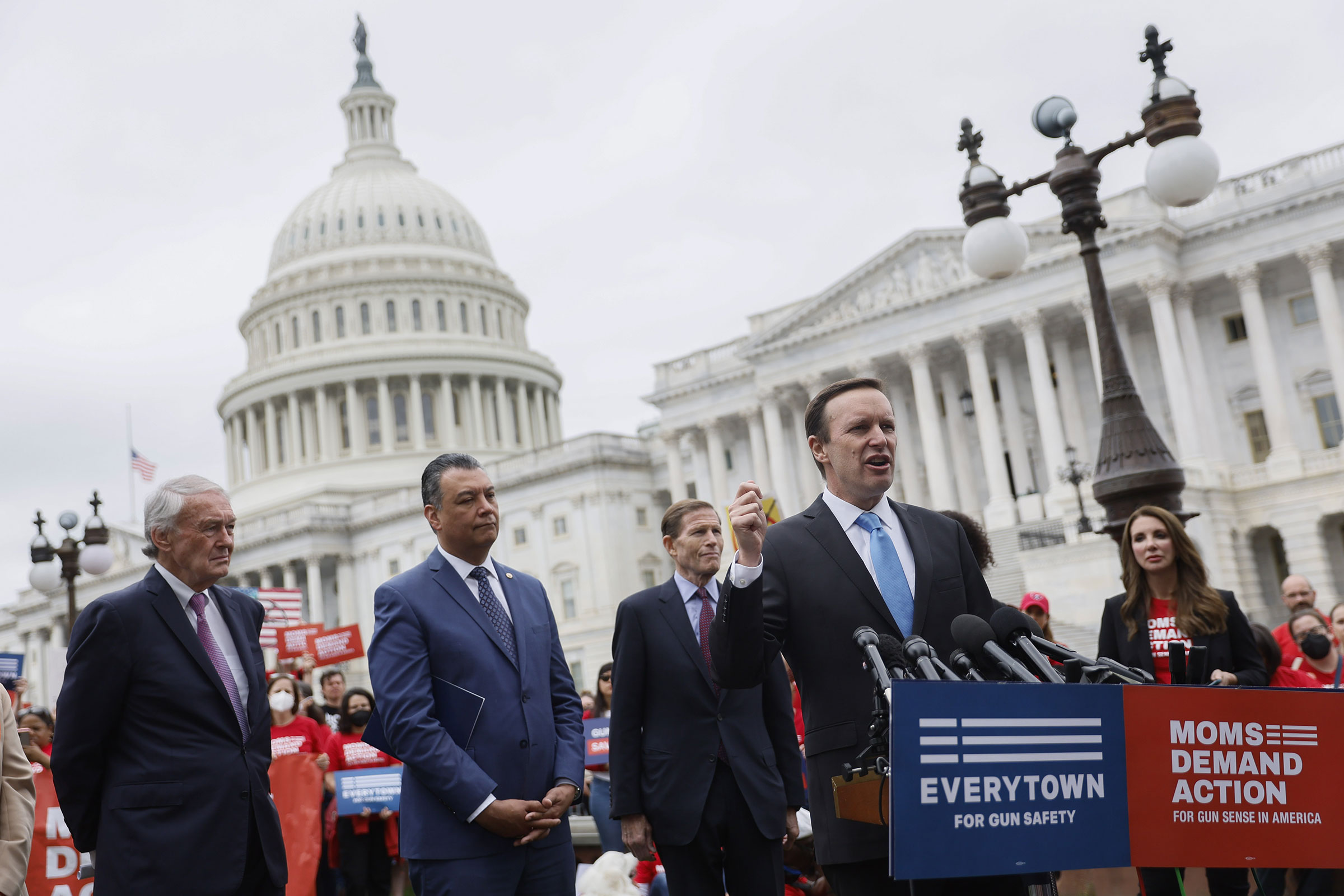Children trapped in a classroom under siege repeatedly called 911 and begged for help during the mass shooting in Uvalde, Texas on Tuesday, while as many as 19 law enforcement officers waited in the hallway outside because they believed the gunman was no longer a threat, authorities said.
“Please send the police now,” a child told operators during one of roughly ten harrowing 911 calls placed by students within 48 minutes, Steven McCraw, director of the Texas Department of Public Safety, said during a press conference on Friday. At least two children called 911 from inside the classrooms where a gunman had killed 19 of their classmates and two teachers.
During that time, officers did not attempt to breach the locked classroom door because the on-scene commander, school district police chief Pete Arredondo, believed there was no longer an active-shooter situation, McCraw said. Arredondo classified the emergency as a “barricaded-subject situation” and waited for a specialized tactical team from the U.S. Border Patrol to arrive, more than an hour after the gunman entered the school.
“It was believed, like I said, at the time, that the subject was stationary, barricaded, there was no risk to other children,” said McCraw, the latest law enforcement official to offer a dramatic revision of the shooting timeline. “Clearly, they were at risk.”

The new details from the Texas Department of Public Safety are sure to raise even more hard questions about the police response to the deadliest school shooting in nearly a decade. Parents who gathered at the school in the midst of the shooting urged police to enter the school and confront the gunman. Perhaps the most troubling revelation is that children inside the two classrooms where the gunman barricaded himself were still alive and also asking for help.
“With the benefit of hindsight, where I’m sitting now, of course it was not the right decision. It was the wrong decision, period. There’s no excuse for that,” McCraw said. “It should’ve been an entry as soon as you can.”
After crashing his truck in a ditch and shooting at two bystanders, the 18-year-old gunman began shooting at the school from the parking lot at 11:31 a.m. Tuesday. About that time, patrol vehicles arrived at a funeral home across from the school—where two people had reported the gunman fired on them after the crash. A school resource officer responded to a 911 call at that time, but drove past the gunman, who hid behind a car in the parking lot.
The gunman entered Robb Elementary School at 11:33 a.m. through a door that had been propped open and began shooting into two adjoining classrooms, McCraw said.
At 11:35 a.m., three Uvalde police officers entered the building, and two suffered “grazing” gunshot wounds as the shooter fired on them when they approached the door to the classroom.
By 12:03 p.m., there were as many as 19 officers in the school hallway. During a 911 call at 12:16 p.m., a child reported that eight or nine students were still alive in one of the classrooms. But the surviving children were not evacuated until 12:51 p.m., after officers finally unlocked the doors with the keys from a janitor, and a U.S. Border Patrol tactical team killed the gunman, according to 911 call records cited by McCraw, who did not answer questions about how many children in those two classrooms ultimately survived the shooting.
He said at least two of the children who called 911 did survive.
“If I thought it would help, I’d apologize,” McCraw said during Friday’s press conference.

Parents criticized police response
The damning new details come as some victims’ family members have voiced frustration about the police response. As the shooting unfolded, parents and onlookers outside the school urged officers to run into the building to stop the gunman, the Associated Press reported.
Javier Cazares, whose fourth-grade daughter, Jacklyn Cazares, was killed, said he arrived at the school to find police gathered outside. He suggested that bystanders charge into the building together. “Let’s just rush in, because the cops aren’t doing anything like they are supposed to,” he told the AP. “More could have been done.”
Other parents said they were handcuffed by police officers as they waited in anguish outside the school and urged law enforcement to take action. Angeli Rose Gomez, whose two children attend the school, told the Wall Street Journal that federal marshals put her in handcuffs “for intervening in an active investigation,” after she implored officers to enter the school building. The stepfather of a child who was killed in the attack was restrained and handcuffed by a police officer when he ran toward the school to try to help her, the New York Times reported.
The Uvalde attack is the deadliest school shooting since 20 students and six faculty members were shot and killed at Sandy Hook Elementary School in Connecticut nearly a decade ago—and the third-deadliest school shooting in U.S. history.
There have been 27 shootings in K-12 schools this year, according to an Education Week tracker—already more than the 24 school shootings that took place in both 2018 and 2019. There were 34 school shootings last year, as the widespread return to in-person learning also meant a return to the threat of violence in schools.
What do we know about the victims?
A “bubbly” 10-year-old boy who had been looking forward to a summer of swimming, a girl who often sang along with her father as he drove her to school, and a young boy who recently learned football passes from his grandfather were among those killed in the shooting.
Students at Robb Elementary had attended an awards ceremony earlier in the day on Tuesday, where some received awards for perfect attendance.
Fourth-grade teacher Eva Mireles was also killed. According to the school website, she had been teaching for 17 years. In a Facebook post, her daughter shared memories about Mireles, who sang karaoke, shared funny TikTok videos and called her daughter every day when she left work.

“I will forever say your name so you are always remembered, Eva Mireles, 4th grade teacher at Robb Elementary who selflessly jumped in front of her students to save their lives,” she wrote. “Mom, you are a hero.”
Irma Garcia, a fourth-grade teacher who taught at Robb Elementary for 23 years and has four children of her own, was also killed. Her husband of 24 years, Joe Garcia, died Thursday of what family members described as “a broken heart.” He was a school police officer in the district.
At least 17 people were injured, though none have life-threatening injuries, Texas Gov. Greg Abbott said. Four of the injured were taken to University Health hospital in San Antonio, 85 miles east of Uvalde, including a 66-year-old woman and a 10-year-old girl who remained in serious condition on Friday, a 9-year-old girl in good condition, and a 10-year-old girl who had been discharged from the hospital as of Friday. Others, including 13 children, were transported to Uvalde Memorial Hospital.

What we know about the gunman
The suspected gunman was identified as Salvador Ramos, who had reportedly dropped out of Uvalde High School. Abbott said Ramos had no known history of mental health issues and no previous criminal record.
In private Facebook messages sent about 30 minutes before he arrived at the school Tuesday, Ramos said he was going to shoot his grandmother, then said he had shot her and said, “I’m going to shoot an elementary school.”
Andy Stone, a spokesperson for Facebook parent company Meta, said they were “private one-to-one text messages that were discovered after the terrible tragedy occurred.” “We are closely cooperating with law enforcement in their ongoing investigation,” he said.
Ramos lived with his 66-year-old grandmother, who contacted police after he shot her in the face. He fled and crashed a pickup truck outside the elementary school.
Authorities said Ramos had purchased a semi-automatic rifle with a debit card at a local sporting goods store. The following day, he purchased 375 rounds of ammunition for the rifle. And days later, he bought a second semi-automatic rifle at the same store. While authorities said Wednesday that the weapons had been purchased in March, reporting by the New York Times found that Ramos purchased the rifles days before the shooting — one on May 17, a day after his 18th birthday, and a second rifle on May 20.
Democrats push for gun control legislation
Abbott, a Republican, said Tuesday that state leaders would “do everything that is necessary to ensure that crime scenes like this are not going to be repeated in the future.”
But advocates for stronger gun-safety measures criticized Republicans for blocking gun-control legislation, even as mass shootings continue to devastate communities across the country. Ten people were shot and killed at a supermarket in Buffalo, N.Y., on May 14, by an alleged gunman who espoused white-supremacist views and targeted Black shoppers.
“Too many members on the other side of the aisle are disconnected from the suffering of the American people. Too many members on that side care more about the NRA than they do about families who grieve victims of gun violence,” Senate Majority Leader Chuck Schumer said on the Senate floor Wednesday, condemning “a plague of gun violence that has taken over this country.”

And on Wednesday, Texas officials made clear they have no intention of changing their stance on gun legislation. “I do my deer hunting here in Uvalde County,” Dade Phelan, speaker of the Texas House, said during the press briefing, moments after describing the shooting as an “unspeakable tragedy.”
Abbott pointed to examples of violence in other states that have passed stricter gun-control laws. “What you’re talking about, it’s not a real solution,” he said.
Sen. Chris Murphy, who represents Connecticut, where the Sandy Hook shooting took place, urged his colleagues to take action on gun-safety measures that could prevent future mass shootings.
“Just days after a shooter walked into a grocery store to gun down African American patrons, we have another Sandy Hook on our hands. What are we doing?” Murphy said, speaking on the Senate floor Tuesday. “Why are you here, if not to solve a problem as existential as this?”
“It is our choice to let it continue,” he said.

Educators also spoke out, calling on lawmakers to make schools safe places for students and teachers.
“Tragedies like this one keep happening while elected officials do nothing; except, in Texas’ case, make firearms more available. How many more mass shootings need to happen before these lawmakers finally take responsibility and address the gun safety issue?” Texas State Teachers Association President Ovidia Molina and National Education Association President Becky Pringle said in a joint statement. “We owe it to our students and educators to make our schools safe and welcoming places where every student can thrive.”
Meanwhile, in an emotional press conference before the Golden State Warriors tipped off against the Dallas Mavericks in Game 4 of the Western Conference Finals, Warriors coach Steve Kerr lashed out at U.S. lawmakers for their inaction on gun control legislation.
“Any basketball questions don’t matter,” said Kerr, whose father Malcolm, while serving as the president of the American University of Beirut, was shot and killed on campus in 1984.
“When are we going to do something?” Kerr said, pounding his hand on a table. “I’m so tired of getting up here and offering condolences to the devastated families that are out there … I’m sorry, I’m tired of moments of silence. Enough.”
Kerr criticized senators who haven’t voted on H.R. 8, the Bipartisan Background Checks Act, which passed in the House a year ago.
“There’s a reason they won’t vote on it,” Kerr said. “To hold on to power. So I ask you, [Senate Minority Leader] Mitch McConnell, I ask all of you senators who refuse to do anything about the violence and school shootings and supermarket shootings. I ask you, are you going to put your own desire for power ahead of the lives of our children and our elderly and our churchgoers? Because that’s what it looks like. It’s what we do every week. So I’m fed up. I’ve had enough.”
Overnight, in a Facebook post, Uvalde mayor Don McLaughlin said: “My heart is broken for them all. I ask everyone to lift them up in prayers for God to surround [them] with his love and comfort. To our community- I know your hearts are broken.”
One of the deadliest school shootings in U.S. history
The Tuesday shooting at Robb Elementary School is the third deadliest school shooting in modern U.S. history. It also marks the deadliest mass shooting at a school since the attack on Sandy Hook Elementary School in 2012.
The shooting at Uvalde means that three of the ten deadliest school shootings in the U.S. have now taken place in Texas. Here is the list of the deadliest shootings at K-12 schools and colleges in the U.S. in order of the number of fatalities.
Uvalde’s influence in the Chicano Movement
Uvalde is a small community of about 16,000 people, located between San Antonio and the U.S.-Mexico border—roughly an hour away from each. Its population is nearly 80% Hispanic or Latino, with 10% of residents born outside the country, according to Census data.
Covering roughly 8 square miles, it’s the kind of rural city where everyone knows each other, attends the same schools and places of worship, and shares in each other’s pain. “We are at the crossroads of cultures with our language and customs,” the city’s website reads.
The city — known for its vibrant immigrant culture and its reputation as the “Honey Capital of the World” — is the hometown of actor Matthew McConaughey, Roy Rogers’ wife Dale Evans, and former Vice President John Nance Garner.
Uvalde played a role in the Chicano Movement of the late 1960s and early ‘70s, which saw a rise in Mexican Americans from California to Texas fighting for better working conditions and against discrimination in education.
Students in colleges and high schools staged walkouts to protest school segregation, the poorer quality of education Mexican American students received, low retention of Latino educators, discipline in the classroom for speaking Spanish, school districts actively holding back high-performing Latino students, and myriad other issues. One such school walkout took place in Uvalde on April 14, 1970. An estimated 500-600 students took part in the protest, which was organized after the school board refused to renew the contract of a beloved Mexican American middle school teacher who advocated for Spanish-speaking students and was one of the few Latino educators in the Uvalde school system—though the small town was, and still is, made up of a Latino majority. The walkout lasted six weeks, possibly the longest school walkout during the Chicano Movement.
Students who participated in the Uvalde walkout describe making the decision to participate despite the sacrifice of their own educational prospects. The Uvalde school board ultimately required the participants of the walkout to drop out or repeat an academic year, according to oral histories collected by the University of Texas at Austin. But collectively, the walkouts across the American Southwest led to an increase in Latino educators in higher positions of power, increases in integration, and changes to the discipline Spanish-speakers faced.
“I think it took several years to see any results, as far as having more Spanish-speaking teachers, as far as being more lenient, as far as you were allowed to speak Spanish if you needed to,” one protestor, Sergio Porras, told the University of Texas. “I contributed to a change here.”
More Must-Reads from TIME
- Why Trump’s Message Worked on Latino Men
- What Trump’s Win Could Mean for Housing
- The 100 Must-Read Books of 2024
- Sleep Doctors Share the 1 Tip That’s Changed Their Lives
- Column: Let’s Bring Back Romance
- What It’s Like to Have Long COVID As a Kid
- FX’s Say Nothing Is the Must-Watch Political Thriller of 2024
- Merle Bombardieri Is Helping People Make the Baby Decision
Write to Katie Reilly at Katie.Reilly@time.com